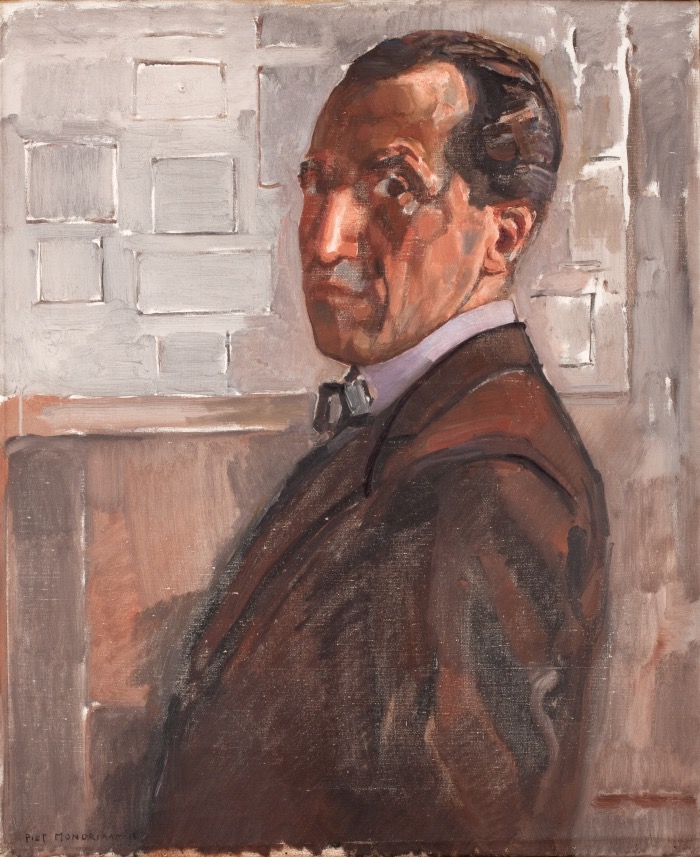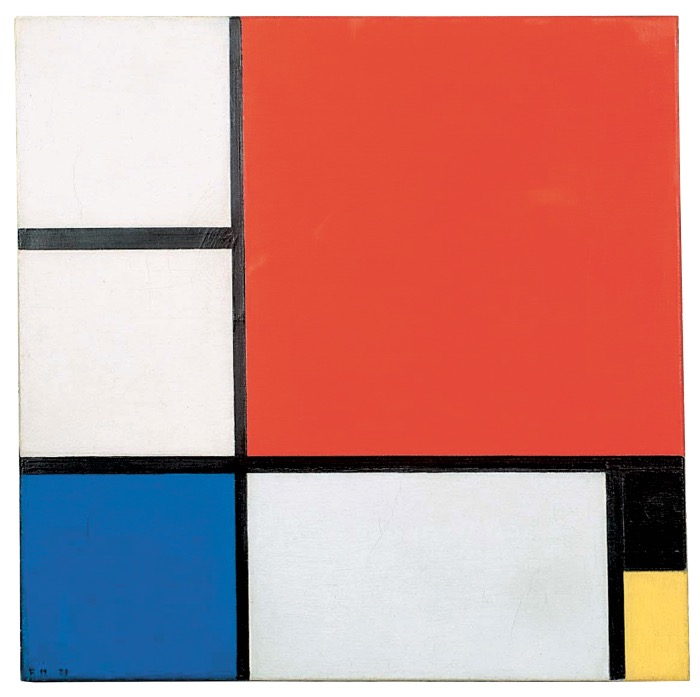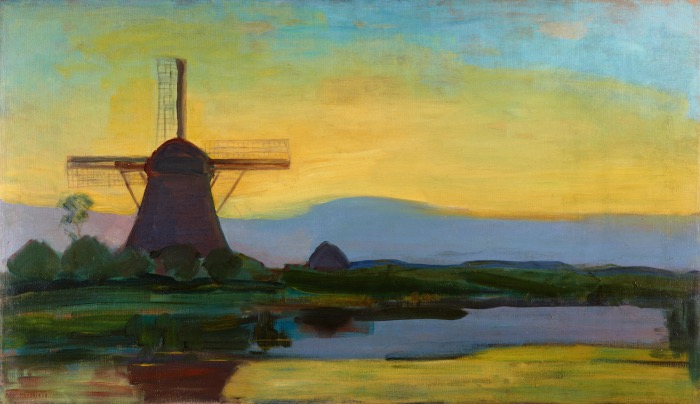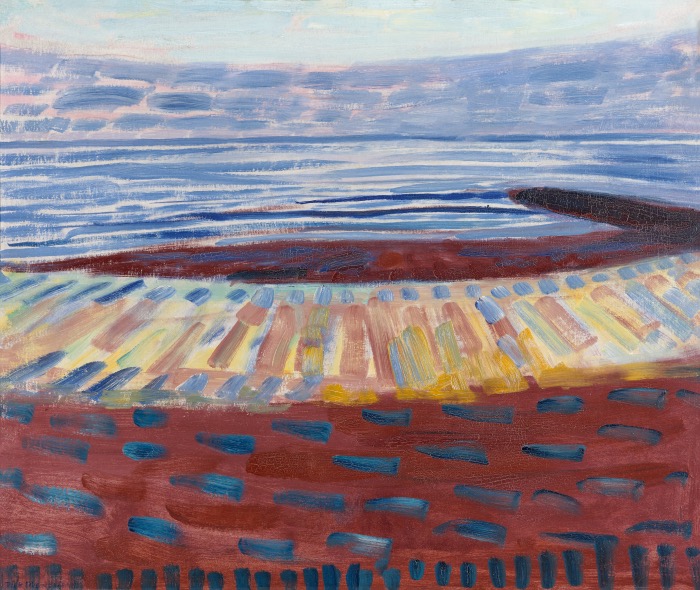
Piet Mondrian (1872-1944), Self-Portrait- 1918. Oil on canvas. Kunstmuseum Den Haag
PIET MONDRIAN: 5 THINGS TO KNOW ABOUT HIS LIFE
Piet Mondrian is an internationally renowned artist and anyone is able to recognize his unique style, characterized by lines and geometric figures.
But not everybody knows that those perfect paintings are the result of a long artistic journey that made Mondrian paint also beautiful landscapes.
In this post I’ll bring you to the discovery of Piet Mondrian, his life and works.
Piet Mondrian’s life

Piet Mondrian (1872-1944), Composition II. 1929. Oil on canvas. The National Museum in Belgrade
1. PIET MONDRIAN’S ARTISTIC TRAINING
From 1892 to 1895 Piet Mondrian received a traditional artistic training at the Rijksakademie van Beeldende Kunsten (the State Academy of Fine Arts) in Amsterdam where he took courses in life drawing, still-life painting and theory of art. In his spare time, however, he fully dedicated himself to landscape painting.
After the diploma, Mondrian painted landscapes just outside Amsterdam. The flat landscape of the Netherlands lends itself well to the search for the contrasts, and his early landscapes show how Mondrian played with rhythm and order on the canvas many years before his abstract works.
2. THE LANDSCAPE IN PIET MONDRIAN’S WORKS
Piet Mondrian’s works the Dutch master is famous for as a pioneer of “Abstract” art are actually the result of a long research and a progressive stylistic evolution that has its starting point in Naturalism and Impressionism.
Mondrian goes through a series of phases, from post-Impressionism to Fauvism, from Symbolism to Cubism, to develop a unique and inimitable style.
A central part of his artistic production is the landscape painting, predominant in all the first phase of his artistic career.

Piet Mondrian (1872-1944), Oostzijdse Mill with Extended Blue, Yellow and Purple Sky – c. 1907-1908. Oil on canvas. Kunstmuseum Den Haag
3. MONDRIAN TOWARDS ABSTRACT ART
Starting from 1900 Mondrian gradually abandoned the faithful representation of the nature, in order to experiment forms and colours. By using vertical and horizontal elements of the landscape, Mondrian explores the possibility of reducing the world surrounding him to its absolute essence: a rhythm of surfaces, colours and lines.
Since 1908 Mondrian’ s work became more and more radical. He didn’t paint naturalistic landscapes anymore and found inspiration in theosophy and artistic novelties coming from abroad. Under these influences, his work went through different phases.
4. MONDRIAN AND PARIS
In 1912, in order to focus on the innovation in his painting, Piet Mondrian moved to Paris. He was already famous as a landscape painter in the Netherlands, he was almost 40 years old and in France was almost a stranger.
The paintings of his early years in Paris are grey and influenced by Cubism of Pablo Picasso and Georges Braque. This direction led him to reduce his expressive language to nothing else but straight lines, primary colours and straight surfaces.
He called this style Neoplasticism.
5. MONDRIAN AND NEW YORK
In 1938 Mondrian left Paris to move to London before and New York then.
Nazism and WWII obliged him to find a safer place where he could continue to work and experiment.
Actually, the works Mondrian began in New York show the beginning of a new language that, however, he couldn’t carry on because he died in 1944.

Piet Mondrian (1872-1944), Sea after the Sunset – 1909. Oil on cardboard. Kunstmuseum Den Haag


Sicuramente Mondrian genio dell’astrattismo con Malevic e Kandinsky obbedisce sicuramente all’ analitica metafisica di aristotelica memoria cioè lo scomporre il veduto in parti sempre più piccole per “coglierne” l’essenza. Un po’ come la scienza positivista approcciava in periodi analoghi. Bisogna dire però che il vero precursore di un simile atteggiamento fu Paul Cezanne. Comunque è questo “coglierne” che andrebbe discusso. Piet Mondrian (così come altri) cercava la verità ? tutta la sua opera era improntata a questo ? L’astrattismo è la ricerca della verità portata alle estreme conseguenze raggiunte da Malevic ? (quadrato bianco su fondo bianco) Rothko e Pollock sono ri-partiti da Malevic e dai risultati di Mondrian ? Gli sviluppi del calcolo infinitesimale moderno da Netwon a Laplace hanno influito sull’evoluzione artistica ? Parrebbe di sì. Ma la verità è ancora lungi da conoscere.
Riflessione interessante. Certamente Mondrian fa parte di un gruppo di artisti che hanno segnato un periodo ben preciso della storia dell’arte. Un periodo in cui l’arte tentava di cogliere la complessità del mondo e dell’essere umano.
Tutto il Novecento è stato caratterizzato dalla ricerca di verità e spiritualità. Credo non si possa comprendere Mondrian se non studiamo il legame tra arte e teosofia, che ha caratterizzato anche molti altri artisti a lui contemporanei.
Diversamente dai cubisti, che Mondrian ebbe modo di conoscere durante il lungo soggiorno a Parigi, egli tentava di conciliare la sua pittura con le sue ricerche spirituali. Nel 1913 cominciò a fondere la sua visione d’arte e i suoi studi teosofici in una teoria che segna la sua rottura finale con la pittura che rappresentava la realtà.
Per Mondrian l’artista deve avere un impegno preciso: ricercare costantemente l’universale, ovvero impegnarsi nella ricerca di quella che lui chiama “realtà pura”.
Il suo è un tentativo di dare un senso ordinato, logico, lineare a una realtà che non ha senso. E nel Novecento lo smarrimento degli esseri umani verso una realtà che non sembrava avere più un senso era forte, basti pensare ai drammi delle due guerre mondiali, al nazismo e alle varie forme di discriminazione che si sono andate affermando lungo tutto il secolo.
Le opere di Mondrian denotano la stretta relazione con i suoi studi filosofici e spirituali. Nel 1908, infatti, si interessa al movimento teosofico di Helena Petrovna Blavatsky, diffusosi a partire dalla fine dell’Ottocento, e l’anno successivo entra a far parte della sezione olandese della Società Teosofica.